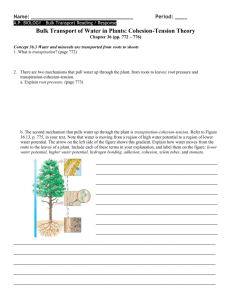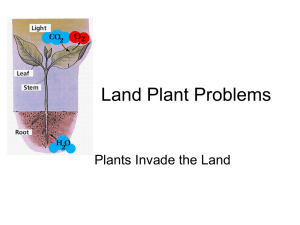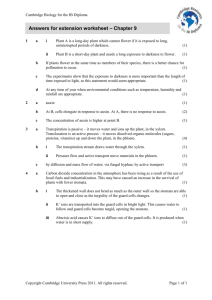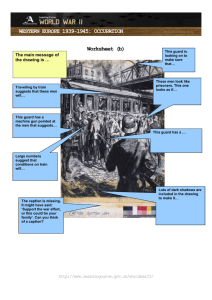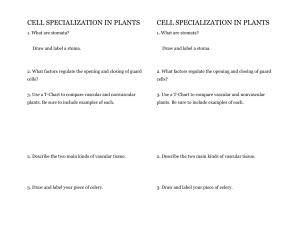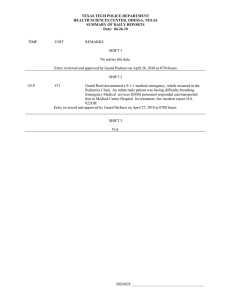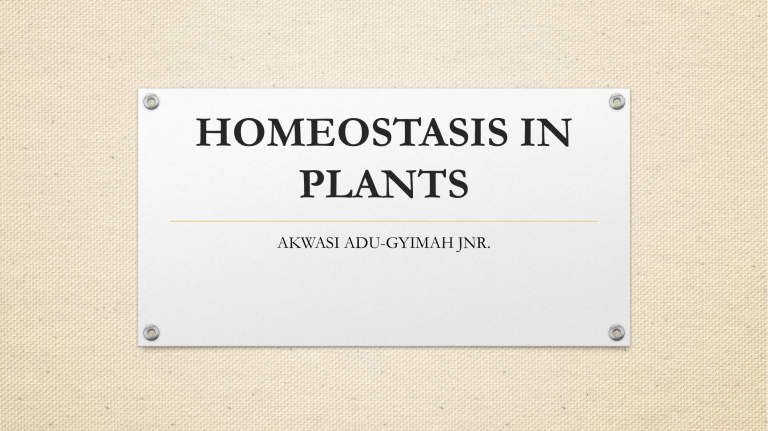
HOMEOSTASIS IN PLANTS AKWASI ADU-GYIMAH JNR. SKILLS • Explain that stomata have daily rhythms of opening and closing and also respond to changes in environmental conditions to allow diffusion of carbon dioxide and regulate water loss by transpiration; • Describe the structure and function of guard cells and explain the mechanism by which they open and close stomata; • Describe the role of abscisic acid (ABA) in the closure of stomata during times of water stress. THE DAILY RHYTHMS OF STOMATA OPENING AND CLOSING Stomata tend to open in Stomatal opening during daylight and close in the the day maintains the dark. inward diffusion of carbon dioxide as well as the However, stomata show outward diffusion of daily rhythms of opening oxygen as well as the and closing and even when outward diffusion of water kept in constant light or vapour in transpiration. constant dark, these rhythms persist. This daily rhythm (pattern) is however, over-ridden if and when the plant becomes short of water and starts to wilt. Stomata open in response to: increasing light intensity low carbon dioxide concentrations in the air spaces within the leaf. WHAT CONDITIONS INFLUENCE THE OPENING OF STOMATA? Stomata close in response to: darkness high carbon dioxide concentrations in the air spaces in the leaf WHAT CONDITIONS INFLUENCE THE CLOSING OF STOMATA? low humidity high temperature water stress, when the supply of water from the roots is limited and/or there are high rates of transpiration. The daily rhythm of stomata closing and opening persists even when plants are kept in constant light b; and in long periods of constant dark c STRUCTURE AND FUNCTION OF GUARD CELLS Each stomatal pore is surrounded by two guard cells. Guard cells have unevenly thickened cell walls; The walls adjacent to the pore (inner walls) are very thick, whereas the wall furthest from the pore (outer walls) are thin. NOTE: The guard cells open when they fill with water and become turgid There are bundles of cellulose microfibrils arranged as hoops around the guard cells so that, as the cell becomes turgid, they mostly increases in length and not in diameter. The ends of the two guard cells are joined and the thin outer walls bend more readily than the thick inner walls as the cells become turgid. THE MECHANISM OF STOMATA OPENING AND CLOSING ATP-powered proton pumps in the cell surface membrane of guard cells actively transport H+ out of the guard cells; The low H+ concentration and negative charge inside the cell causes K+ channels to open; K+ diffuses into the guard cell down an electrochemical gradient; Starch stored in the guard cells is converted to organic acids, particularly malate; The high concentration of these ions (K+ and malate) inside the guard cells lowers the water potential; Water moves in by osmosis, down a water potential gradient The entry of water increases the volume of the guard cells, so they become turgid and expand. The thin outer wall expands most, so the cells curve apart. ABSCISIC ACID AND CLOSURE OF STOMATA Abscisic acid (ABA) is a plant stress hormone that is secreted by plants in times of water stress (very dry conditions); ABA binds to receptors on the cell surface membrane of guard cells; This inhibits proton pumps so that H+ are not pumped out of the guard cells; The result is a build up of H+ inside the guard cells; ABA stimulates the influx of Ca2+ by opening Ca2+ channels; Ca2+ acts as a second messenger and encourages the efflux of K+ as well as anions such as Cl-; Thus water potential of guard cells increases and water moves out of the guard cells by osmosis; The volume of the guard cells decreases and the guard cells become flaccid; The stomata responds quickly by closing. THE END! •THANK YOU.
